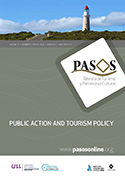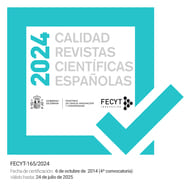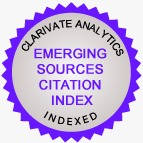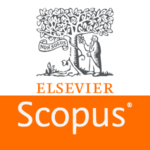The impact of urban policy on the management of the historic-tourist city: a comparative study
DOI:
https://doi.org/10.25145/j.pasos.2016.14.046Keywords:
Cultural Tourism, Urban Heritage, Urban PlaningAbstract
Several policies influence in the management of the tourist-historic tourist city, which can be grouped into cultural, tourist, economic and urban development. This research focuses on the challenges and solutions brought by the latter in order to manage the tourist use of the most visited areas of the historic city. To do so, three cases have been studied: Plymouth, Malaga and Guanajuato. Having case studies from different contexts permits the extraction of various alternatives to similar problems and to assess the implementation of common tools in distinct realities, which can serve as reference for other cities that are engaged in renewing their historic centres to make them more attractive to visitors.
Downloads
Publication Facts
Reviewer profiles N/A
Author statements
- Academic society
- PASOS. Revista de Turismo y Patrimonio Cultural
- Publisher
- Instituto Universitario de Investigación Social y Turismo. Universidad de La Laguna (España) - Instituto Universitario da Maia ISMAI (Portugal)
References
Ashworth, G.J. y Page, S.J. 2011. “Urban tourism research: recent progress and current paradoxes”. Tourism Management, 32: 1-15.
Ashworth, G.J. y Tunbridge, J.E. 2000. The tourist-historic city. Retrospect and the prospect of managing the heritage city. Oxford: Pergamon. 1999. “Old cities, new pasts: Heritage planning in selected cities of Central Europe”. Geojournal, 49: 105-116.
Ayuntamiento de Guanajuato. 2003. Plan Maestro para la Preservación del Patrimonio Cultural del Municipio de Guanajuato.
Ayuntamiento de Guanajuato, Dirección General de Desarrollo Urbano y Obras Publicas, Dirección de Asuntos Jurídicos y Dirección de Catastro. 2002. Plan de Conservación para la Zona Declarada Patrimonio de la Humanidad.
Ayuntamiento de Guanajuato, Dirección General de Desarrollo Urbano y Obras Publicas, Dirección de Planeación y Ecología. 2000. Plan Parcial de Ordenamiento Territorial de la Zona de Valenciana.
Ayuntamiento de Guanajuato, Gobierno de Guanajuato, IMPLAN Guanajuato, UNAM, PUEC. 2011. Plan de Ordenamiento Territorial del Centro de Población y Programa de Desarrollo Urbano de Guanajuato.
Ayuntamiento de Guanajuato, Secretaria de Desarrollo Urbano y Obras Públicas, Secretaria de Ecología y Desarrollo Urbano. 1998. Plan Parcial de la zona de Crecimiento Yerbabuena-Colonia Burócrata zona suroeste.
Ayuntamiento de Guanajuato, Secretaria de Desarrollo Urbano y Obras Públicas, Secretaria de Ecología y Desarrollo Urbano, Secretaria de Desarrollo Social y Humano. 2002 Plan de Ordenamiento Territorial de la Ciudad de Guanajuato.
Ayuntamiento de Guanajuato, Servicios Públicos Municipales, Seguridad Pública, Obras Públicas, Desarrollo Económico, Turismo, Desarrollo Urbano. 1998. Plan de Desarrollo Municipal 1998-2000.
Ayuntamiento de Málaga. 2011a. Iniciativa Urbana. Análisis del espacio público usos y actividades económicas en el ámbito del PEPRI Centro.
b. Plan Especial de Protección y Reforma Interior del Centro de Málaga. PAMPEPRI (83) M.
c. Plan General de Ordenación Urbanística.
d. Plan Municipal de Movilidad Sostenible.
Centro Histórico y Monumental: Entorno de Interés Protegido.
a. Plan Especial de Protección y Reforma Interior Conde Ureña. PAM-LE.1 (97).
b. Plan Especial de Protección y Reforma Interior Falda del Seminario. PALE. 23 (97).
c. Plan Especial de Reforma Interior Perchel Alto. PAM-R.3 (83) M.
Plan Especial de Protección y Reforma Interior San Cristóbal. PAM-LE.2 (97).
a. Plan Especial de Protección y Reforma Interior Perchel Sur. PA-P.13 (97).
b. Plan Especial de Protección y Reforma Interior Trinidad-Perchel. Modificado y texto refundido PAM-R4.
Ayuntamiento de Málaga, Servicio de Programas Europeos. 2006 Málaga 05 Agenda 21.
Barrera-Fernández, D. 2013. “Políticas incidentes en la adecuación turística de la ciudad histórica”. AGIR - Revista Interdisciplinar de Ciencias Sociais e Humanas, 1(5): 94-120.
Bayona, V.R. y Sánchez, S. 2015. “El Ayuntamiento inyecta 600.000 euros al Museo del Automóvil desde 2012”. Málaga Hoy, 20 de agosto de 2015.
Bellet Sanfeliu, C. y Llop Tomé J.M. 2004. “Miradas a otros espacios urbanos: las ciudades intermedias”. Scripta Nova. Revista electrónica de Geografía y Ciencias Sociales, 8: 157-180.
Bramwell, B. y Sharman, A. 1999. “Collaboration in local tourism policymaking”. Annals of Tourism Research, 26(2): 392-415.
Brito, M. 2009. Ciudades históricas como destinos patrimoniales. Una mirada comparada: España y Brasil. Sevilla: Junta de Andalucía, Consejería de Cultura.
Burdett, R. y Sujdic, D. 2008. The endless city. London: Phaidon.
Burtenshaw, D., Bateman, M. y Ashworth, G.J. 1991. The European city. A western perspective. Londres: David Fulton Publishers.
Capel Sáez, H. 2014. El patrimonio: la construcción del pasado y del futuro. Barcelona: Ediciones del Serbal.
Carta de Cracovia
Principios para la conservación y restauración del patrimonio construido. Conferencia Internacional sobre Conservación “Cracovia 2000”.
Fainstein, S.S. y Judd, D.R.
“Global forces, local strategies and urban tourism”. En: Fainstein, S.S. y Judd, D.R. (Eds.). The tourist city. New Haven: Yale University Press.
Fundación CIEDES. 2005. La Carta Verde de Malaga / Agenda Local 21.
García Hernández, M. 2003. Turismo y conjuntos monumentales. Valencia: Tirant lo Blanch.
Gilbert, D. y Clark, M. 1997. “An exploratory examination of urban tourism impact, with reference to residents attitudes, in the cities of Canterbury and Guildford”. Cities, 14(6): 343-352.
Gobierno del Estado de Guanajuato. 2005. Plan de Manejo del Área Natural Protegida “Presa de la Purísima y su Zona de Influencia”.
Graham, B. y Howard, P. (Eds.). 2008. The Ashgate Research Companion to Heritage and Identity. Londres: Ashgate.
Gu, K. y Wall, G. 2007. “Rapid urbanization in a transitional economy in China: the case of Hainan Island”. Singapore Journal of Tropical Geography, 28(2): 158–170.
Gunay, Z. 2008. “Neoliberal urbanism and sustainability of cultural heritage”. Comunicación presentada en el 44th ISOCARP Congress. Dalian, 19-23 de septiembre de 2008.
Gutiérrez Palomero, A. 2009. “El mètode Urban i la seva difusió com a valor afegit principal de la iniciativa comunitària”. Documents d’Anàlisi Geogràfica, 53: 47-67.
Jansen-Verbeke, M. y Lievois, E. 2001. “Analysing heritage resources for urban tourism in European cities”. En: Pearce, D.G. y Butler,
R.W. (Eds.), Contemporary issues in tourism development. Londres y Nueva York: Routledge.
Law, C.M. 1996. Urban tourism. Attracting visitors to large cities. Londres y Nueva York: Mansell Publishing Limited.
LDA Design. 2005a. Sustainable Neighbourhood Assessment City Centre.
Exeter. 2005b. Sustainable Neighbourhood Assessment Devonport.
Exeter. 2005c. Sustainable Neighbourhood Assessment Stonehouse.
Exeter. Lievois, E. 2007. “The tourism interaction system: a new approach on the geography of inner city tourism”. Comunicación presentada en el 44th Congress of the European Regional Science Association. Paris, 29 de agosto - 2 de septiembre de 2007.
Matrix Partnership. 2003. Devonport Development Framework. Preparado para Devonport Regeneration Company.
MBM Arquitectes y AZ Urban Studio. 2003. A Vision for Plymouth. Final Copy. Page, S.J. 1995. Urban tourism. London: Routledge.
Page, S.J. y Hall, C.M. 2003. Managing urban tourism. Harlow: Prentice Hall.
Plymouth City Council. 2008a. Ebrington Street Conservation Area Appraisal and Management Plan.
b. The Hoe Conservation Area Appraisal and Management Plan.
a. Adelaide Street Conservation Area Appraisal and Management Plan.
b. Barbican Conservation Area Appraisal and Management Plan.
c. Devonport Conservation Area Appraisal and Management Plan.
d. Local Development Framework. Core Strategy.
e. Millfields Conservation Area Appraisal and Management Plan.
f. North Stonehouse Conservation Area Appraisal and Management Plan.
g. Stonehouse Peninsula Conservation Area Appraisal and Management Plan.
h. Union Street Conservation Area Appraisal and Management Plan.
Plymouth City Council, Department of Development. 2010. City Centre and University Area Action Plan 2006-2021.
Sutton Harbour Area Action Plan 2006-2021.
a. Devonport Area Action Plan 2006-2021.
b. Millbay and Stonehouse Area Action Plan 2006-2021.
Hoe Area Action Plan. Issues and options.
Popp, M. 2012. “Positive and negative urban tourist crowding: Florence, Italy”. Tourism Geographies, 14(1): 50-72.
Romero Moragas, C. 2001. “Ciudad, cultura y turismo: calidad y autenticidad”. PH Boletín, 36: 100-109.
Russo, A.P. y Van der Borg, J. 2002. “Planning considerations for cultural tourism: a case study of four European cities”. Tourism Management, 23: 631-637.
Troitiño Vinuesa, M.A. 2003. “Ciudades históricas y turismo sostenible”. A Distancia, 1: 47-51.
Troitiño Vinuesa, M.A. y Troitiño Torralba, L. (Dir.). 2011. Estudio sobre la funcionalidad turística del patrimonio cultural del municipio de Carmona y estrategias de actuación. Trabajo conjunto de Grupo de Investigación Turismo, Patrimonio y Desarrollo, Instituto Andaluz de Patrimonio Histórico y Ayuntamiento de Carmona.
Tyler, D., Guerrier, Y. y Robertson, M. 1998. Managing tourism in cities. Chichester: Wiley.
Van den Berg, L., Van der Borg, J. y Van der Meer, J. 1995. Urban tourism. Performance and strategies in eight European cities. Aldershot: Ashgate.
Velasco González, M. 2011. “La política turística. Una arena de acción autónoma”. Cuadernos de Turismo, 27: 953-969.
“Gestión turística del patrimonio cultural: enfoques para un desarrollo sostenible del turismo cultural”. Cuadernos de Turismo, 23: 237-253.
Vernon, J., Essex, S., Pinder, D. y Curry, K. 2005. “Collaborative policymaking. Local sustainable projects”. Annals of Tourism Research, 32(2): 325-345.
Ward, C. 2013. “Probing identity, integration and adaptation: Big questions, little answers”. International Journal of Intercultural Relations, 37: 391-404.
Warnken, J., Russell, R. y Faulkner, B. 2003. “Condominium developments in maturing destinations: potentials and problems of long-term sustainability”. Tourism Management, 24(2): 155-168.
Downloads
Published
How to Cite
Issue
Section
License
I confirm that the work is original (of my/our authorship), and that it will not be submitted to other journals or publications until the final resolution of the review process in PASOS, RTPC.
I authorize the publication of my work by PASOS, PSTN of free and open access in any of the formats that I deem appropriate, for an indefinite period of time and as a non-remunerated collaboration.
Likewise, the author(s) understands that the published work may be linked or deposited on any server or included in other publications (republication), provided that the new place and/or new edition references the original publication and acknowledges the authorship and copyright ownership of PASOS RTPC publications.
Authors understand that a plagiarism-self-plagiarism check will be performed, and the article may be removed at any time from the editorial flow.










